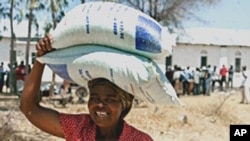A new United Nations report finds food security in Zimbabwe has improved significantly, following government efforts to curb the food problem and international funding to subsidize farmers. But, the report finds nearly 1.7 million people in the country still will need food aid next year. The findings are based on a report by the U.N. Food and Agriculture Organization and World Food Program, who sent a joint food assessment mission to Zimbabwe in June.
The report is a good news/bad news story. Zimbabwe has had several years of bad harvests. And, the country's critical food shortages worsened in 2008, when food prices soared around the world.
During the pre-harvest season in the early part of 2009, the World Food Program was feeding 5.3 million hungry people in Zimbabwe.
But World Food Program spokeswoman, Emilia Casella, says the number of aid recipients dipped to fewer than one million people a month last year, thanks to a notable improvement in crop yields.
"There has been a 20 percent increase in the planting area for maize in Zimbabwe and that is quite significant," Casella says. "It is the biggest amount of maize that was planted in Zimbabwe in the past 30 years. And that is a very encouraging change. It means that Zimbabwe in 2010 has had 1.35 million tons of maize harvested, and that is compared to less than half a million tons in 2008. This improvement is obviously going to help many people in Zimbabwe."
Nevertheless, Casella says there is still a big shortfall of food in the country. And, the high food prices are affecting the poorest people who cannot afford to buy what they need.
"So, we are anticipating that in the next pre-harvest season in the early part of the coming year, the World Food Program is expecting to have to provide assistance to 1.6 almost 1.7 million people during the lean season in the beginning of 2011," Casella adds. "So, Zimbabwe has shown great improvement, but there is still a great need."
The report notes the general poverty and chronic food insecurity in Zimbabwe has led to little diversity in the food people consume. It says the food shortages also have contributed to an increased prevalence of chronic malnutrition among young children.
Food Security in Zimbabwe Improves, Many Still in Need
- By Lisa Schlein






